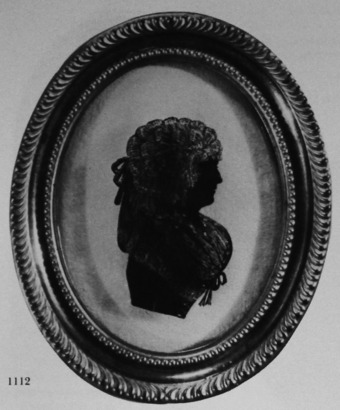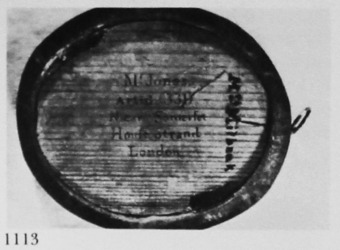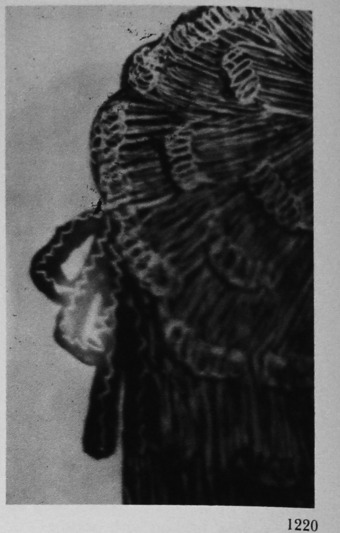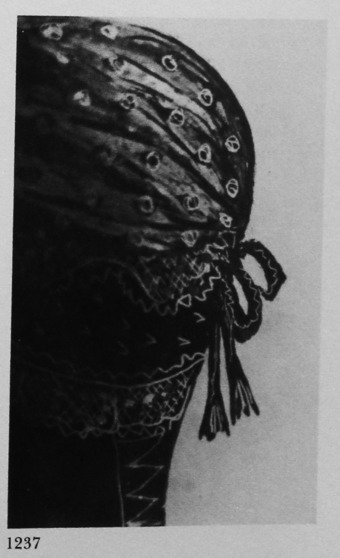Jones, Abraham (McKechnie Section 3)
See also Sections One and Two
Recorded as 'Mr Jones' by Long and Jackson (The History of Silhouettes). Recent research has established that the first name of this profilist and seller of mechanical contrivances for the production of silhouettes was Abraham, although in practice he referred to himself in many advertisements simply as 'Mr Jones'. Until recently, no identified work by Jones was known, but a silhouette on glass, bearing his stencil on the back, has come to light, and for this reason the main entry on him is included in this Section. It is likely, however, that a number of profiles painted on paper, either ascribed to other artists or unidentified, were executed by Jones, for he appears to have been a sufficiently good artist to teach drawing over a period of years, as well as to paint and draw in pencil and water-colour.
That Jones was working as early as c. 1779 is evident from a reference in an article on William Gardiner (q.v.) published in the Gentleman's Magazine after Gardiner's death in 1814. According to this source, Jones was producing profiles cut in brass foil in c. 1779; these seem to have been painted in some fashion, for Gardiner had been employed 'in daubing the portraits of any who were fools enough to sit for [him]'. (Unfortunately, I have seen none of these brass profiles.) Since we know, therefore, that Jones was in business by c. 1779, we can assume that he was probably born as early as 1760.
Jackson mentions that early in 1781 Jones was in Bath, and that later he was living at 270 Oxford Street, London. In December he was in Norwich; we know this from an advertisement in the Norwich Mercury (29 December), recorded by Trevor Fawcett in an unpublished paper, 'Art in Norwich before the Norwich School'. In this advertisement Jones describes himself as an 'artist’, offers profiles at 2s 6d each (frame included), and refers to work 'with the Air and Contour of the Head and Bust in the true style of the Greek and Roman medallions' (possibly this was cut work).
Jackson quotes an advertisement from which we learn that early in 1782 Jones was living at 7 Coventry Street and 168 Strand, London. It refers extensively to his activities as an inventor of mechanical contrivances for the taking of profiles:
Likenesses of certainty taken with Royal Patent Instruments, Reflecting Mirrors at one guinea each. Jones's new invented Mirrors, with which any Lady or Gentleman may take the most perfect Likenesses of any person whatever, in proper colours, either in profile, three quarters or full face; they are made on so curious a plan, that a child of ten years old cannot fail to take a perfect likeness with them. Also his new invented mathematical instruments, at Half a Guinea each, for reducing Profile shades to any size whatever. These instruments have long been wished for by several artists and the public at large, as they also reduce maps, prints etc. Mr. Jones by study, labour and practice has brought them on so easy a principle that every Lady or Gentleman has the opportunity to take the Likeness of his own little family or friends at the trifling expense of Half a Guinea. Mr. Jones not doubting but that several imitations will be made to impose on the public, he hopes they will note No. 7 Coventry Street and No. 168 Strand as no person whatever will be appointed to the sale of them on his account in London, and they are all stamped with his name.
Another advertisement, dating from the same year, is included in one of the volumes (1, page 221) of early press cuttings in the Victoria and Albert Museum, London; it is dated September 1782 in a contemporary hand:
STRIKING LIKENESSES
In miniature profile, taken in one minute by Mr. Jones, Artist and Drawing-Master, from Bath. — That no person may be deprived of their own or friend's likeness, they will be done at so small a sum as half a crown. Nothing required, unless the most striking likeness is obtained. — Any lady or gentleman having shadows by them of their living or deceased friends, may have them reduced to any size, and the likeness most critically preserved in the miniature. —Miniatures highly finished, and neatly set for the neck or arm, at two guineas and a half each, equally to many done at five guineas. — Likewise teaches the art of painting on silk, in imitation of needle-work, tambour, &c. in the space of four hours, though the person never made use of pencil before. Also teaches the art of painting on glass. — That no lady may lose the opportunity of learning these arts, they will be instructed at one guinea each. Nothing required till the pupil be fully instructed. Specimens may be seen each day, from twelve till seven, at No. 137, facing Catherine street, in the Strand. — Also his new invented Camp Paper, for writing and drawing, without pen, ink, or pencil.
An advertisement in the Northampton Mercury (30 December) establishes that Jones was in this town at this time; the similarity of the wording leaves us in no doubt that the advertiser was the same 'Mr Jones':
STRIKING LIKENESSES
in
MINIATURE PROFILE
(on an entire new Plan, and with great Improvements)
TAKEN in ONE MINUTE, by Mr. JONES, Artist and Drawing Master, from the Royal Academy, London — That no Person may be deprived of their own or a Friend's Likeness, they will be done at so small a Sum as HALF-A-CROWN: Nothing required unless the most striking Likeness is obtained.
Likewise Teaches the Art of Painting on SILK, in Imitation of Needle-Work, Tambour, &c. in the Space of four Hours; though the Person never made Use of Pencil before — Also Teaches the Art of Painting on GLASS. That no Lady may lose an Opportunity of learning these Arts, they will be instructed at ONE GUINEA each. Nothing required tilt the Pupil be fully instructed.
Specimens may be seen each Day from Twelve till Seven, at Mr. Balaam's, Sadler, Northampton.
N.B. His New-Invented CAMP Paper, for Writing and Drawing, without Pen, Ink, or Pencil.
Other advertisements recorded by Jackson include one sent in from 32 Ludgate Street and another in the Manchester Mercury (29 July 1783), which includes the following words: 'Artist and Drawing Master from London, Likenesses in Miniature and Profile to represent the whole Drapery, and in Particular the Head-dress. Taken in One Minute at 2s. 6d. each. Visits Manchester.'
Two further advertisements, both recorded by Jackson, appear to be indirectly related to Jones. The first, dated January 1785, reads as follows:
LIKENESSES. To the Ingenious world. There now is to be had a mathematical Instrument by which any Person for the expense of half a guinea may reduce miniature profiles for themselves . . . All orders to be sent to Brookes' Portfolio Manufactory, 2 [sic; now known to have been 28; see Brookes' Portfolio Manufactory], Coventry Street. The Golden Head, next house to the Golden Head [sic], in Leicester Square.
Specimens may be seen every day as above, and from 12 to 5 at No. 7, Coventry Street.
Profiles taken and shaded with all drapery at 2s. 6d. each. Ladies taught the art of painting on silk to imitate needle-work, Tambour, &c, in three lessons at one guinea each. Nothing required unless the pupil be fully instructed. All orders from any part of the Kingdom post paid, punctually attended to, with proper directions how to use either instruments.
The second advertisement is quoted here only in part; for the full text see the entry on Brookes' Portfolio Manufactory: 'LIKENESSES. To the ingenious world. There is now to be had an ingenious mathematical Instrument by which any Person for the expence of half a guinea may reduce Miniature Profiles of themselves or a thousand different persons in a most correct manner — All orders to be sent to Brookes' Portfolio Manufactory, No. 2 [sic; the correct number is 28], Coventry Street. (The Golden Head, next house to the corner of Oxendon Street.)'
Jones was evidently marketing his 'machines' through the help of the Henry Brookes' ‘Portfolio Manufactory', which was at an address opposite 7 Coventry Street (premises which Jones intermittently occupied, and certainly appears to have been occupying in January 1785).
Another advertisement dating from 1785 is included in one of the Volumes (1, page 252) of early press cuttings in the Victoria and Albert Museum:
No. 168, near New Church, Strand [St Clement Danes]
Likenesses of certainty taken with Royal Patent Instruments of Reflecting Mirrors at one guinea each.
JONES' new invented Mirrors with which any Lady or Gentleman may taken the most perfect Likenesses of any person whatever, either in profile, three-quarter, or full face; they are made in so curious a plan that a child of ten cannot fail to take perfect Likenesses with them. Also his new-invented mathematical instruments at half a guinea each, for reducing profile shades to any size what ever. These instruments have been long wished for by several artists and the public at large, as they also reduce maps, prints, &c. Mr. Jones, by study, labour, & practice, has brought them on so easy a principle that every lady or gentleman has the opportunity to take the Likenesses of their own little family or friends at the trifling expense of half a guinea.
Profiles taken & shaded, with all the drapery, at 2s. 6d. each.
Another advertisement is included on a sheet (No. 380) in one of the volumes (volume 1) of early press cuttings in the Victoria and Albert Museum. The sheet is undated, but, to judge from its position in the volume, may bear press cuttings dating from c. 1788. The text of the advertisement is as follows:
LIKENESSES
No. 331, facing Somerset House, Strand
By his Majesty's special appointment. To the curious in copying drawings, and paintings.
The various, beautiful, and almost incredible effects of Mr. JONES's new-invented Optical Instruments, for copying drawings, paintings, natural flowers, insects, &c. it giving the true likeness, on paper to any size either as large as life, or so small in miniature, in one minute, with all their proper colours, either by day or candle-light. Price two guineas each, with proper directions.
Likewise the Reflecting Mirror, at one guinea, for taking perfect likenesses, landscapes, &c. Admittance one shilling each lady or gentleman to view the above instruments, which will be returned on purchasing either, or sitting for an impression plate likeness.
Likenesses in crayon, at 15s each, gilt frame included.
Likenesses taken in miniature profile, painted on glass, in a stile of superior excellence, at 5s. each, with an elegant gilt frame included.
Ladies taught the art of painting on silk, sattin, tiffany &c., and to imitate needlework, tambour, &c., in the space of four hours (by regular drawing and painting) though the person never made use of a pencil before, at two guineas each lady, a complete set of colours included. Likewise teaches the art of painting on glass.
Specimens of the above instruments, and paintings to be seen every day, from eleven till five only; or a line directed, post paid, will be attended to.
This itinerant artist eventually took a house and settled down in 1799.
The rate books of the parish of St Marylebone show that Jones took up residence at 4 Wells Street on Lady Day, 1799; they also provide the evidence that his first name was Abraham. The rate books continued to list him until 1809, when he either moved elsewhere or may have died. There is no record of his death in the St Marylebone parish records, but the theory that he died in late 1809 or in 1810 is supported by the fact that entries for him in the Post Office Directory and in Holden's Directory (which begin in 1802) end in 1810. In these entries he is listed as an artist, but in 1810 he is entered as 'Sole Proprietor and Original Inventor of the Polygraphic or Manifold writers'. This suggests that he had invented an early model of the typewriter, though there is no record to this effect in the Encyclopaedia Britannica.
I give below a summary of what we know of Jones's travels and activities, with emphasis on what we can learn from his advertisements of his work as a profilist:
1779 Jones takes 'brass profiles'.
1781 Early in the year in Bath.
Later at 270 Oxford Street, London.
In December in Norwich, selling profiles.
1782 Early in the year at 7 Coventry Street and 168 Strand, London, taking 'likenesses ...
in proper colours'
In the summer in Bath and in September at 137 Strand, facing Catherine Street,
taking ‘striking likenesses in miniature profile' in both centres.
In December in Northampton, taking 'striking likenesses in miniature profile'
1783 Early in the year at 32, Ludgate Hill, London
In July in Manchester, taking 'likenesses in miniature and profile to represent the
whole drapery, and in particular the head-dress'
1785 In January at 7 Coventry Street, London: 'Profiles taken and shaded with all
drapery at 2s 6d each'
1788(?) At 331 Strand, London: `Likenesses in crayon, at 15s each, gilt frame included.
Likenesses taken in miniature profile, painted on glass, in a style of superior
excellence, at 5s each, with an elegant gilt frame included.'
1790 In Reading, advertising his reflecting mirrors
1798 At 293 Oxford Street, London
1800 At 4 Wells Street, London
Jackson records the address 32 Ludgate Street, London, but gives no date.

Mrs Milbank
Silhouette painted on convex glass
1788
4 x 3¼in./102 x 83mm.
Trade Label
Frame: oval, hammered brass, backed with paper
Author’s collection

Trade label of Abraham Jones, from the silhouette illustrated in 1112.
Author’s collection
DETAIL

Woman’s hair. Detail from a silhouette by Abraham Jones. The strokes made with the needle look rather stiff. (1112)

Front of a woman’s dress. Detail from a silhouette by Abraham Jones. The detail was executed entirely with a needle. (1112)
